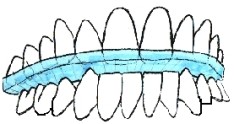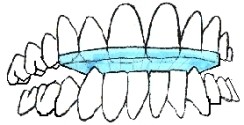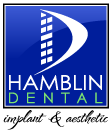TMJ Treatment Salt Lake
No Drugs, No Surgery New Dental Device Prevents Migraine Pain
Dr. Hamblin provides the most current treatment for TMJ and migraine headaches and jaw in Salt Lake City, Utah. The FDA has granted marketing allowance for the NTI Tension Suppression System (NTI-tss) indicated for the prevention and treatment of medically diagnosed migraine and migraine associated tension-type headache pain.
In a multi-center clinical trial, and here in our Sandy, Utah office, the NTI-tss device was shown to significantly reduce or eliminate migraine and migraine associated pain. It is considered breakthrough technology in that there is, when used as directed, no risk of side effects associated with it compared to many current pharmaceutical migraine therapies.
Patients who experience such migraine headaches contract their temporal muscles during sleep on average 14 times more intensely than patients who do not experience them, and have been found to exhibit pericranial tenderness (muscle tenderness of the scalp). The NTI-tss device is a small, removable, prefabricated, clear resin matrix oral insert that a dentist fits to the patient?s front teeth to be worn while sleeping. With the NTI-tss device in place, the intense activity of the temporal muscle (which closes and clenches the jaw) is suppressed to less than 1/3 of maximum by preventing any contacting of the back molar teeth. By reducing this neuromuscular activity, migraine headache pain is reduced or prevented all together, as well as the migraine associated tension-type headaches.
In the United States, according to the results of the 1992 American Migraine Study that appeared in The Journal of the American Medical Association, it is estimated that 23 million persons older than 12 years of age suffer severe migraine headaches. The social and economic impact of migraine is staggering, with estimates approaching $17.2 billion per year in lost productivity.
There is no known cause of or cure for chronic migraine. Commonly prescribed migraine drugs have not been shown to prevent or stop every incident of migraine, and their benefit does not exceed 50% greater than treatment with placebo.
The pivotal NTI-tss clinical trial involved 94 patients. Each patient was diagnosed by a physician as having at least two migraine episodes per month and having many headaches. Each patient was prescribed Imitrex® (sumatriptan, GlaxoSmithKline) by a physician for use as a migraine rescue medication. The patients were divided into two groups. Fifty-one (51) patients were fitted with the control device, and 43 patients were fitted with the NTI-tss device. TMJ relief makes life so much easier. TMJ dentistry can be found here in Sandy Utah, right outside Salt lake City.
After eight weeks of NTI-tss use, patients in the NTI-tss group did not experience any measurable evidence of new pain or discomfort as a result of using the NTI-tss. The device did not cause pain in use.
Clinical performance data showed a decrease of migraine episodes of 61.9% with the NTI-tss device compared to 38.1% with the control. (82% of the NTI-tss users had a 77% average reduction of migraine events.)
The need for Imitrex® rescue for the NTI-tss group was reduced by 46.8% compared to 17.6% for the control group.
The NTI-tss group showed a 78% reduction in nausea compared to a 40.4% reduction in the control group.
NTI-tss reduced all head pain episodes by 46.9% compared to a 25.1% reduction by the control and a 36.9% reduction in the intensity of head pain versus a 23.7% reduction by the control.
In our office, we can fabricate the removable NTI-tss device in one visit. The device is worn primarily while asleep. Many dentists across the country are already highly experienced in its use after years of providing the NTI-tss for its earlier indications for the prevention of TMJ syndrome, grinding, clenching, and bruxism. Approximately 200,000 patients have been treated to date for these indications.
Unsuccessful Treatment History
We receive many inquiries from patients who have had previous treatments for TMJ or Headaches. Usually, these inquiries include concerns about the fact that previous treatments, bite appliances and braces did not help their problem.
From our experience, treatments with medications (such as Imitrex, narcotics, pain relievers, and other agents) are usually not beneficial and can cause more long term problems. Some medications, such as Corgard, can be effective to a certain degree, but must be monitored carefully by your neurologist and cardiologist.
Although a complete neurological assessment is critical to proper diagnosis, most medical treatments aimed at curing head pain are not successful. It is somewhat hard to understand why physicians cannot help headache sufferers, and skepticism is not unusual for patients that do not understand how a dentist can cure headaches and facial pain.
If you have received previous bite appliance treatments and your pain has not subsided, then we would advise you to have a second opinion regarding the adequacy of your treatment. The majority of the appliances that we evaluate lack efficacy.
Some appliances can actually worsen your pain. That is why we advise all of our readers to find a skilled specialist who can properly diagnose pain and implement effective treatment. Likewise, a lot of orthodontic care can actually cause more pain, if not performed judiciously.
TMJ Craniofacial Treatment Costs
Many readers also want to know the cost of treatment. Although it is impossible for us to quote any prices without proper diagnosis, we can tell you that prices for such treatments start at approximately $275 and can range into thousands of dollars. Some patients can benefit from a simple device, such as a NTI deprogrammer, while other patients require extensive reconstruction.
The average cost at our office is $950 for the first phase of treatment. We guarantee all of our patients will achieve at least 95% reduction in pain, or we will refund their money. We don’t know of any other specialists who treat head pain problems that can be bold enough to make such promises!
Contact Dr. Hamblin at (801) 255-7645 to obtain any additional information you may need for utilizing our evaluation service.
Did you know that 90% of all headaches and related head and neck pain are caused by TMJ (Temporomandibular Joint) disorders? More than 23 million people suffer from chronic headaches, which force them to miss more than 157 million workdays a year.
However, more than half of all sufferers never see a doctor. Dr. Scott Hamblin uses the latest dental techniques to accurately diagnose and effectively treat TMJ disorder and its symptoms.
In many cases, Dr. Hamblin can custom fit TMJ patients with the NTI Tension Suppression System (NTI-tss) device, which when worn over a period of time can eliminate many of the symptoms associated with TMJ. The NTI-tss device is FDA approved for the treatment of medically diagnosed migraine pain, as well as migraine associated tension-type headaches.
Headache Facts
Jaw clenching muscles of migraine suffers are 70% larger in volume and generate significantly higher bite forces than control subjects. (Muscles enlarge and strengthen resulting from habitual intense exercise)
Migraine sufferers who experience headaches soon after or upon waking show significant evidence of nocturnal jaw clenching.
Pericranial tenderness (soreness of the muscles of the scalp upon palpation) is present in every migraine and tension-type headache sufferer, while absent in controls . (Pericranial tenderness results from over work of a muscle, i.e., jaw clenching during sleep)
Tension-type headache patients contract their temporalis muscles (clench their jaw) during sleep, on average, 14 times more intensely that asymptomatic controls.
Simple minimal voluntary jaw-clenching (of less than 30% of maximum effort) for 30 minutes (with two rest periods) still results in a headache for 63% of migraine sufferers (6). Jaw clenching during sleep can frequently exceed voluntary maximum.
A traditional dental mouthpiece can allow for clenching intensity and resultant symptoms to perpetuate or intensify.
A mouth guard or night guard can take Migraines or headaches away.
A device which prevents molar and canine tooth contacts reduces clenching intensity to 1/3 of maximum.
The NTI-tss, which prevents molar and canine tooth contact while being worn during sleep, provides a 77% average reduction in migraine pain episodes for 82% of migraine sufferers.
NTI-TSS
Bruxism
Bruxism, an unconscious grinding and clenching of the teeth, can cause migraines, damage teeth, and contribute to temporomandibular dysfunction. The primary causes of bruxism are stress and tension. Dentists have found that the NTI-tss can prevent clinching and grinding.
Migraines
Research indicates that 40 million Americans suffer from migraines or tension headaches. The FDA reported that 82 percent of patients professionally diagnosed with migraines experienced a 77 percent average reduction in attacks in the first eight weeks while using the NTI-tss.
TMJ Dysfunction
Sometimes referred to as TMD, TMJ dysfunction is caused by over stimulation of the trigeminal nerve caused by excessive teeth occlusion. By reducing the intensity of the occlusion, the NTI-tss can relieve TMJ pain.
What is NTI-tss?
NTI-tss stands for Nociceptive Trigeminal Inhibition. Nociceptors are nerves that sense and respond when the body is harmed. They tell the brain of impending damage, injury, or irritation. Trigeminal refers to the nerve which has three sensory divisions within the face and neck. The lower case tss stands for tension suppression system.Once identified, we can often treat bruxism, migraines, or TMJ dysfunction with a revolutionary little acrylic mouthpiece, the NTI-tss device. The estimate for people fitted with the NTI-tss has exceeded 2.25 million throughout the world, and they all thank Dr. Jim Boyd for his invention. Dr. Boyd and his wife, migraine sufferers, were the first two patients to wear the device. Since it relived their migraine pain, it?s helped millions, and it can help you as well.
How Does NTI-tss Work?
Bruxism, many migraines, and TMJ dysfunction result from a jaw muscle/nerve malfunction. The NTI-tss interrupts the involuntary tug of war between the jaw’s side and temporal muscles, reducing clenching intensity by one-third, thus reducing the barrage of negative impulses transmitted by nerves. Furthermore, the device causes muscles to relax in a stable position so that you and those hyperactive malfunctioning muscles can rest. Often this eliminates bruxism-related migraines and various kinds of TMJ pain. Some patients experience relief after one night, while others find comfort after a few weeks of wearing the NTI-tss.
The Facts About NTI-tss
Custom made to fit each patient?s unique bite, the NTI-tss appliance features a snap-in fit to stay secure during the night. Children cannot wear the standard device, but a special appliance made for primary teeth can be made. Believe it or not, many insurance policies will help cover the costs of the appliance because it is FDA approved for migraine treatment and falls under the category of oral appliance or splint.
If you suffer from bruxism, migraines, or TMJ pain, ask about the NTI-tss. You deserve relief.
NTI-Tss For Migraine Headaches
The new NTI-tss tension suppression system is the only FDA-approved dental appliance for preventing migraine headache pain. As seen on ABC’s Good Morning America, the NTI-tss is a small, virtually invisible mouthpiece that covers only your upper front teeth while you sleep. The NTI-tss must be custom-fitted by a dentist qualified to use the system-which usually takes only one 30-minute visit.
In a clinical trial, 82% of migraine sufferers who used the NTI-tss for 8 weeks had a 77% average reduction in migraine attacks and the need for medication usually taken to treat migraine pain.
How Does An NTI-Tss Work?
This is a simple demonstration of the efficacy of the NTI-tss device.

Begin by gently biting on the moon portion of your fingernail, using your central incisors. Only be forceful enough to create slight discomfort.

Now attempt to use the same amount of force, but this time bite with a canine tooth on the same spot of your fingernail as you did with the central incisors.
What happens? Biting with the canine tooth is suddenly more painful than with the incisors… Why?
The incisor teeth are intended to not only incise food, but to be “hardness monitors” of what you’re biting into. They are under your control and tell you if something will be to hard to chew.
The canine teeth are designed for grasping and pressing into what it is that you’re trying to hold on to. The intensity of muscular activity created once the canine teeth have been engaged is under less voluntary control. The message to the brain is: “We’ve opened our mouth to grab something and have caught it…hold on!” The contacting canine teeth encourages jaw clenching!
Dentistry’s attempt at dealing with parafunctional jaw muscle activity (the most destructive of which is jaw clenching) has been to provide alterations of the biting surfaces of the teeth, as shown in the examples below:

A full coverage splint, usually a thickness which mimics the intended space between the teeth when the jaw musculature is supposed to be at rest, provides both canine and posterior teeth contact, thereby allowing for perpetuation of parafunctional muscular activity.

By increasing the thickness of the splint, clenching intensity may be altered, depending on the amount of pressure applied to particular teeth. If contacts are “heavier” in the molar region, clenching intensity can be suppressed. If contacting is prevalent in the canine region, clenching is reflexive.

An anterior bite plane reduces parafunctional intensity of the masseters, and to a degree, the lateral pterygoids, but still provides canine contact for temporalis clenching.
See how the NTI-Tss works to relieve migraines headaches and TMJ pain:
Call Today to Schedule Your Free Consultation (801) ALL-SMILE (255-7645)



